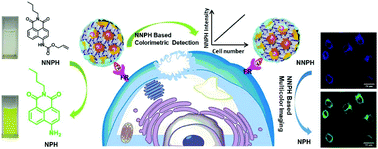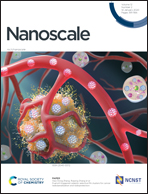Aqueous stable Pd nanoparticles/covalent organic framework nanocomposite: an efficient nanoenzyme for colorimetric detection and multicolor imaging of cancer cells†
Abstract
Accurate, sensitive detection of cancer cells from clinical fluids is helpful for screening and early diagnosis of tumors. Here, we develop a facile approach for in situ growth of palladium nanoparticles in an aqueous stable carboxymethyl cellulose-modified covalent organic framework hydrogel (named Pd NPs/CMC-COF-LZU1). The resulting nanocomposite has been proven to show superior catalytic performance for the transformation of N-butyl-4-NHAlloc-1,8-naphthalimide (NNPH) into N-butyl-4-amido-1,8-naphthalimide (NPH), indicated by significant changes in both color and fluorescence. Based on these features, the designed nanocomposite was used as a signal transducer to develop a colorimetric assay and multicolor imaging for accurate and sensitive detection of cancer cells. The transformation of NNPH into NPH enabled the detection system to perform multicolor imaging of HeLa cells. By using folic acid (FA) as a recognition element, a total of 100 cancer cells (HeLa) can be distinguished in 1 mL culture medium with 10% FBS. We envision that these COF-based composite materials (Pd NPs/CMC-COF-LZU1) have tremendous potential applications in biotechnology and biological sciences.



 Please wait while we load your content...
Please wait while we load your content...